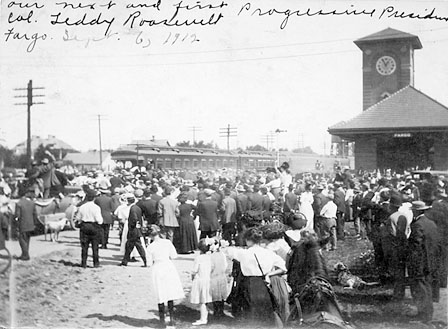U.S. Presidents
Fargo has been host to several US presidents. Some gave speeches and some passed through without a word. Some citizens prefer the former approach, some the latter.
Rutherford B. Hayes was the first. He stopped in Fargo in September 1878, 11 years before North Dakota became a state. Hayes, his wife and the rest of the presidential party had breakfast at the Headquarters Hotel and then got back on the special Northern Pacific train that brought them to Fargo. Hayes said a few words to the crowd from the train’s platform and the train left, carrying the group to a nearby farm. The visit lasted an hour and 20 minutes. The group returned to Fargo for dinner, then went to Glyndon, Minn., where Hayes and his party transferred to the St. Paul and Pacific Railroad.
Chester A. Arthur passed through Fargo in September 1883 but didn't stop. His special Northern Pacific train went through early in the morning while he was on his way from Washington, DC, to Yellowstone National Park. Does this count?

Theodore Roosevelt also was on his way to Yellowstone when he stopped in Fargo April 7, 1903. He spent several hours here, meeting with local dignitaries and touring the city in a carriage. A newspaper account of the president’s appearance mentioned that a snow storm the day before upset plans for the visit and made the streets a mess, but the sun was shining the day he arrived. Roosevelt, who was used to North Dakota weather after ranching in the Badlands in the 1880s, stepped out of the train wearing a fur coat and laughed. “My, I forgot I was in the banana belt,” he quipped. “I don’t need this heavy coat.”
Roosevelt made several additional stops in Fargo which was on the train route to the Badlands, a favorite area for Roosevelt.
Roosevelt was the featured speaker when the cornerstone for the Fargo College Library was laid on September 5, 1910.
Roosevelt visited Fargo On September 6, 1912, when his train stopped at the Great Northern depot. The photograph to the right was taken on that occasion.
Woodrow Wilson went through Fargo early in the morning Sept. 10, 1919, on a swing through the country to urge the United States to participate in the League of Nations. His train stopped in Fargo for a group of North Dakotans to board, but the president stayed in bed. Another "visit" that perhaps should not be counted.
Franklin Roosevelt was in Fargo more than any other president. His first visit was in August 1934, when he made a brief stop after touring the Devils Lake area to look at water supplies because the region was in the midst of a drought. Drought brought him back to the state in August 1936. That time he passed through Fargo early in the morning and didn’t stop. He was on his way to tour Burleigh, Morton and Stutsman counties. He made a short appearance in Fargo in October 1937 while in North Dakota to dedicate a new stadium built with Works Progress Administration assistance in Grand Forks. On his fourth trip, he was on a blacked-out train that went through Fargo early in the morning Sept. 20, 1942. No one knew he’d been here until about two weeks later, when White House officials announced he’d been aboard the train on a war plant inspection trip. He made his last trip to Fargo in August 1944. He was on his way back to Washington, DC, after visiting West Coast military installations. His train stopped in Fargo at 7:45 a.m. for about five minutes. He didn’t appear in public, and few people knew he was aboard the train.
Up to 35,000 people turned out for Harry Truman’s visit to Fargo May 13, 1950. The stop was part of the president’s tour of the western part of the country. Truman spoke from a platform at the Great Northern Railway depot for 22 minutes, then shook hands with visitors. He was back Sept. 29, 1952, to defend his administration and campaign for Democratic presidential candidate Adlai Stevenson. Between 3,000 and 5,000 people turned out for that visit.
Richard Nixon visited Fargo on July 24, 1970, to meet with area governors and mayors to discuss federal funding, a loss of population and other concerns in the Great Plains states About 5,000 people met him as he and his family flew into Fargo’s airport. Most were happy to see him. However, about 40 protesters were in the crowd, carrying peace flags and signs with antiwar slogans. His visit lasted five hours.
On Thursday, March 8, 2001, at 5:20 PM, President George W. Bush spoke to a crowd of 12,000 at Fargo's Bison Sports Arena to urge them to support his tax cut plan. Air Force One appeared at 4:42 p.m., descending out of a slate-gray sky. Its wheels touched down at 4:43pm. NDSU's Gold Star Band entertained the crowd as they waited and then struck up Hail to the Chief as Bush entered. Governor Hoeven welcomed the crowd and introduced President Bush.
